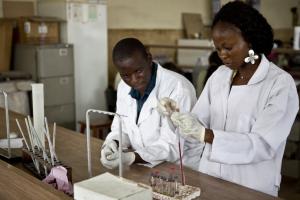What needs to be done to solve the shortage of health workers in the African Region
Brazzaville, Congo/Victoria Falls, Zimbabwe, 24 August 2017 - The sight of a long queue of patients waiting for their names to be called to see the doctor or nurse at a hospital or health centre is a familiar spectacle that drives home the message that the shortage of skilled health workforce is an issue that warrants urgent attention. There is no doubt that hospitals or health centres are busy places. The shortage of skilled health workforce means that a limited number of doctors and nurses have to attend to hundreds of patients daily and quality health care can’t be rushed.
As at 2015, the African Region had an average of 1.30 health workers per 1000 population[1], far below the 4.5 per 1000 required for Sustainable Development Goals (SDGs). Out of the estimated global health workforce shortage of 14.5 million required for Universal Health Coverage (UHC) and SDGs, the African Region has the most severe health workforce (HWF) shortage, estimated to reach 6.1 million by 2030. This is against the backdrop of a vision to ensure that by 2030, all communities have universal access to health workers. As countries in the Region aspire to attain sustainable development goals, health workforce shortages and imbalances could be the Achilles heel that can derail the attainment of these goals.
What needs to be done to address the current situation in Africa? The response is contained in a WHO report to be discussed at the annual meeting of health ministers from the WHO African Region which is taking place in Victoria Falls, Zimbabwe from 28 August – 1 September 2017.
The report titled ‘Framework for the implementation of the global strategy on human resources for health (health workforce 2030) in the African region’, proposes a range of actions that must be implemented by countries by 2022 and 2030.
Among the actions proposed are: Ensuring effective use of available resources. For example in 2014, only Liberia, Rwanda, Swaziland and Zambia met the Abuja Declaration target of allocating 15% of annual budget for health. Although most Member States have national human resources for health (HRH) plans, their implementation has been a challenge. For example, some Member States cannot afford to absorb all health workers (HWs) produced, leading to the paradox of HW unemployment amidst shortages in the health system.
Countries are urged to train more health workers and improve the effectiveness of Community Health Workers (CHWs) programmes as there are cases of some training schools not being accredited which implies that the quality of education provided is not assured. There are only 168 medical schools in the Region, with 24 countries having only one and 11 countries having no medical schools. However, there is significant increase in the number of health science training schools for other categories of health workers, partly due to increasing involvement of the private sector in education.
‘Better incentives to retain staff and also attract back workers from the diaspora should be put in place as well as the use of appropriate ICT tools such as e-learning, electronic health records and telemedicine to improve education and efficiency of health service delivery,” said Dr Matshidiso Moeti, the WHO Regional Director for Africa.
According to the report African countries should prioritise building the capacity of HRH units to develop HRH plans that that quantify health workforce needs, demand and supply of different cadres of health workers. This will help make better decisions on the production, recruitment and retention of sufficient numbers of health workers.
Other actions proposed include strengthening the capacities of the domestic health workforce in emergency and disaster risk management; Align investment in HRH with the current and future needs of the population and health systems; Establishing national registries of practicing health workforce; Strengthening HRH information systems and building the human capital required to manage the systems.
The report lays out some specific targets for the African Region: It is expected that by 2022 all countries in the Region put mechanisms in place to coordinate HWF agenda. At least 23 countries in Region should have established accreditation mechanisms for health training institutions; and HRH investment plan based on the current and future needs of the population. During the same period national regulatory mechanisms to promote health workforce (HWF) safety and adequate oversight of the private sector should be set up as well as National Health Workforce Accounts (NHWA) and HWF observatories and registries.
By 2030, all the 47 countries in the Region would have achieved all the above. Furthermore they should have reduced at least by half inequalities in access to a health worker and have reached at least 80% of the course completion rates in medical, nursing and allied health professional training institutions. In addition to providing technical support for planning and implementing the proposed actions, WHO will also monitor the attainment of the indicators.
[1] WHO AFRO Health Workforce Observatory Database.
Team Leader
Health Systems & Services Cluster
Telephone: +47-241-39300
Email: tumusiimep [at] who.int (tumusiimep[at]who[dot]int)
Communications and marketing officer
Tel: + 242 06 520 65 65 (WhatsApp)
Email: boakyeagyemangc [at] who.int (boakyeagyemangc[at]who[dot]int)



